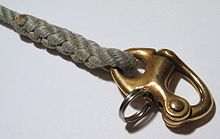- Rope splicing
-
Rope splicing in ropework is the forming of a semi-permanent joint between two ropes or two parts of the same rope by partly untwisting and then interweaving their strands. Splices can be used to form a stopper at the end of a line, to form a loop or an eye in a rope, or for joining two ropes together. Splices are preferred to knotted rope, since while a knot reduces the strength by as much as 40% or more, some splices can retain up to 95% of the strength of the line. However, splicing usually results in a thickening of the line and if subsequently removed a distortion of the rope. Most types of splices are used on 3 strand rope, but some can be done on 12 or greater strand braided rope.
Contents
Types of splices
- back splice (also called an end splice) - A splice where the strands of the end of the rope are spliced directly back into the end without forming a loop. It is used to finish off the end of the rope to keep it from fraying. The end of the rope with the splice is about twice the thickness of the rest of the rope. With nylon and other plastic materials, the back splice is often no longer used; the rope strands are simply fused together with heat to prevent fraying.
- cut splice (originally called cunt splice) - A splice similar to the eye splice. It is typically used for light lines (e.g., the log-line) where a single splice would tend to come undone, the rope being frequently wet.[1] It makes a very very strong knot. A cut splice is a join between two ropes, made by side splicing the ends slightly apart, to make an eye in the joined rope which lies shut when the rope is taut. Its original name was bowdlerised to "cut splice".
- eye splice - A splice where the working end is spliced into the working part forming a loop.
- figure-eight "splice" knot- A splice-like bend knot used for joining two ropes.
- horseshoe splice - A cut splice where the two sides of the loop are of unequal length.
- long splice - A splice used to join two rope ends forming one rope the length of the total of the two ropes. The long splice, unlike most splice types, results in a splice that is only very slightly thicker than the rope without the splice, but sacrifices some of the strength of the short splice. It does this by replacing two of the strands of each rope end with those from the other, and cutting off some of the extra strands that result. The long splice allows the spliced rope to still fit through the same pulleys, which is necessary in some applications.
 A short splice, with ends whipped
A short splice, with ends whipped
- short splice - Also a splice used to join the ends of two ropes, but the short splice is more similar to the technique used in other splices and results in the spliced part being about twice as thick as the non spliced part, and has greater strength than the long splice. The short splice retains more of the rope strength than any knots that join rope ends.
- side splice - A splice in which the end of one rope is joined to the midsection of another. For example, the cut splice (above) is composed of two side splices, with each line's end side spliced to the standing part of the other.
Splices are often tapered to make the thicker splice blend into the rest of the line. There are two main types of tapering, the standard and the "West Coast Taper".
- Standard tapers progressively remove a portion of each remaining strand -- one-third at a time is typical, resulting in a taper of two additional tucks beyond the splice -- thus making each successive tuck produce a narrower splice. This is only practical with laid-lines, i.e., those made up of numerous strands laid side by side.
- West Coast taper (also known as a Fisherman's Taper) is effected by extra-tucks of entire strands, such that the second strand is interweaved one more time than the first and the third is interweaved an additional time after the second.
A mechanical splicing system was invented and patented by Talurit, a Swedish company.
A fid is a hand tool made from wood, plastic, or bone and is used in the process of working with rope. It is conical instrument with a somewhat long taper. A variety of fid diameters are available depending on the size of rope being used.
A Marlinspike is a tool, commonly part of a sailor's pocketknife, used to separate strands of rope from one another. It can be a 3"-4" steel spike, slightly curved, with a non-sharp point that tapers quickly out to a 1/4" to 3/8" shaft in the space of the first 1" length. Marlinspikes for splicing wire rope generally run from 6" up to 36" and are tapered but not curved.
See also
- Knot
- Whipping knot
- Western union splice
- T-splice
- Rat-tail Splice
References
- ^ William Falconer, Universal Dictionary of the Marine (London: Thomas Cadell, 1780), 1243.
External links
- Braided eye splice!
- Eye Splice Animation Using Rope - with Discussion
- New England Ropes Splicing Guide
- Short splice animation
- Eye splice animation
- Steel: The Elements and Rigging and Seamanship (1794) from The Maritime History Virtual Archives
- A. Hyatt Verrill Knots, Splices and Rope Work from Project Gutenberg
- Guide to Wire-Rope Splicing - Mirror1 - Mirror2
Categories:- Knots
Wikimedia Foundation. 2010.



